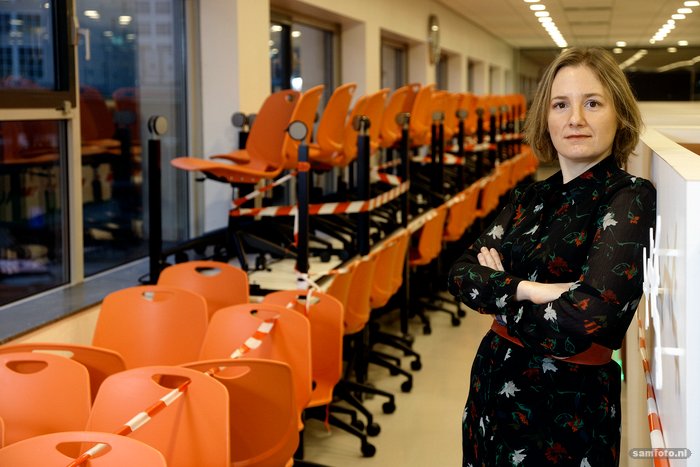Resilience means designing for change
Natural disasters are familiar territory for Dr Tina Comes, researcher in disaster management at TPM and director of research at the 4TU centrum voor Resilience Engineering.
“We all underwent a stress test last year,” said Dr Tina Comes in her online speech about resilience in society on Dies Natalis. She explains how she and her colleagues switched to online research and education. As the parent of a four-year-old son, she also experienced home-schooling at close hand. Without technology for transport and communication, she stresses, we could not have dealt with Covid-19 in the same way. “Without technology,” she concludes, “there is no resilience. Research has played a central role in our ability to adapt. Now more than ever, as vaccines start to arrive.”
Paradoxically, our dependence on technology also increases our vulnerability, as Comes discovered during a working visit to Nepal. Her team was visiting villages near Kathmandu hit by an earthquake in 2015 when she heard rumours that people had died in Amsterdam after a power failure. “Because of a power failure?” asked the bemused villagers. “We have them all the time here and nobody ever dies.” She hesitated – the reason she was there was to explain how people could prepare for natural disasters more effectively. But who was the most resilient now: the victims in Nepal or the technology-addicted people of Amsterdam?
When there is a power failure in Amsterdam, telecommunications no longer work. The traffic lights go out, causing traffic chaos. If it lasts long enough, the petrol pumps also fail and society grinds to a halt. Specialists call it the cascade effect.
Inextricably linked
Anyone who looks for the source of the academic term ‘resilience’ will find its first use in psychology in the 1960s/1970s, referring to people’s ability to recover from trauma. The term was also used in ecology to describe the resilience of natural systems and its limits. If a forest dries out and becomes a savannah, that change becomes irrevocable. The ecological system has passed its tipping point. Two decades later, the term was also used for technical systems, such as a tram connection. If a tree falls across it, how long will it take for transport capacity to recover? The shorter that time, the better the resilience.
In the 4TU Centre for Resilience Engineering, resilience is used in all of these senses: social, technological and ecological. Is it not too wide a concept to be usefully applied? “Of course, it’s easier to consider a technical facility or natural biotope in isolation,” explains Comes. “But that makes no sense, because everything is interconnected in our urban environment.”
As a result of information and communication technology, transport and energy networks are becoming increasingly intertwined with social networks. But that trend also increases vulnerability to external disruptions in the form of floods or diseases. In the last five years, there has been growing realisation that resilience is an overarching concept of social, ecological and technical systems.
The importance of the social and institutional aspect was illustrated last year by the disastrous course of the coronavirus pandemic in the United States. In its assessments, the World Health Organisation takes no account of national governance or social cohesion, explains Comes. Because of this, early impressions of the impact of Covid-19 in the US were far too optimistic. After all, the number of GPs per hundred thousand inhabitants, hospital capacity and the qualifications of medical staff were all completely in order. But the country was hit by more fatalities than anywhere else (over 400,000) because of a lack of social cohesion and a divided strategy rather than a targeted approach. The recent curfew riots also revealed fault lines in the social cohesion in the Netherlands.
No average day
Looking back is one thing, but engineers want to move forward. Comes thinks that this is probably the most important task of the 4TU programme DeSIRE (Designing Systems for Informed Resilience Engineering): translating understanding of resilience into tangible guidance for designers.
Resilient design starts with the realisation that you can no longer assume an average day as the standard, whether it concerns a drainage pipe, a power cable or a road. Because of climate change, averages are no longer stable and outliers are becoming more extreme. Besides, engineers need to understand that their structures will have a determining influence for 50 to 100 years into the (changing) future. According to Comes, this means that infrastructure needs to be adaptable. “We need to plan infrastructure in such a way that we don’t box ourselves in. It may be better to build and reinforce a dyke in phases.”
Will it prove to be more expensive? “The Dutch healthcare system bases its planning capacity on estimated need. In an epidemic, you need to scale that up fast, which makes it an expensive business. Planners tend to assume a narrow band of scenarios, despite the fact that experience shows that this is not a sensible strategy. Designers need to factor in a radically different use of their creations: buildings should be made in such a way that they can be rapidly rebuilt and cities need to adapt to high water levels. Resilience means designing for change.”
The 179th dies natalis of Delft University of Technology had Resilience as its theme. On diesnatalis2021.nl you can listen to the speeches of researchers who discussed this topic.
